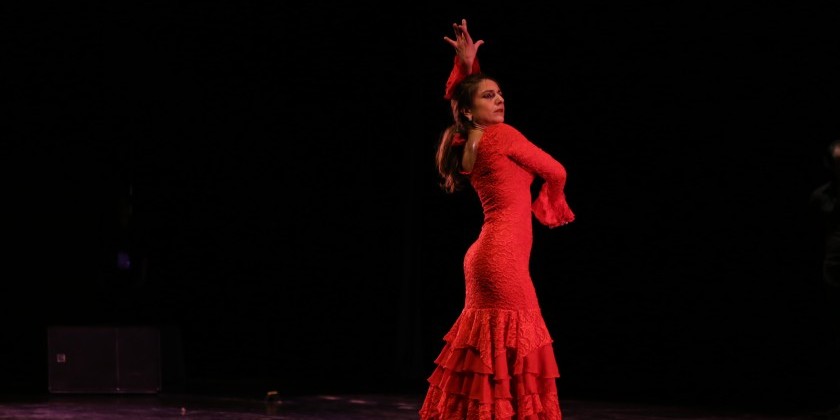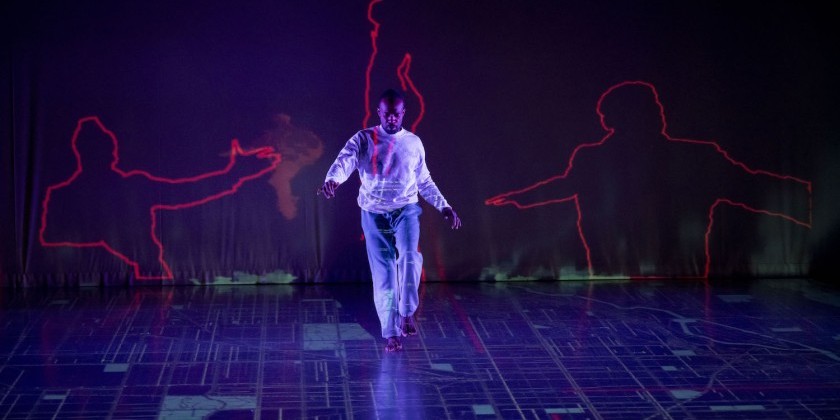IMPRESSIONS: Larissa Velez-Jackson's Holy Now!

Danspace Project September 23-25, 2010
Betsy England 2010
Humorous Admonishments for Dance and Ourselves
St. Mark’s in the Bowery is oldest site of continuous worship in New York City and the site of Dancespace Project’s performances for thirty-five years, making it a place of both religious and artistic devotion. In her new piece, Holy Now!, choreographer Larissa Velez-Jackson plays on these facets of St. Mark’s, likening attitudes surrounding dance and choreographers to religious adoration.
At the beginning of the piece, dance and encounters with the divine are synonymous. Velez-Jackson, Sarah Holcman, and Katy Pyle sit in three chairs at the front of the stage, each facing a different section of the audience seated on all three sides. They lift their faces to the lights beaming down from the balcony, and resting the backs of their hands on their knees, they wear beatific expressions of contentment. At the back of the stage, to the right of the altar, Abigail Levine registers a different experience of facing God, terror, and her mouth forms a frightened “O” as she faces her maker. The four sit in these positions for ten to fifteen minutes. Dance and religious experience collapse -- it is hard to tell whether the women are performing a part, or actually in the midst of divine encounters.
Grabbing a microphone, Levine jumps on a chair and barks well-known phrases often heard in dance class. “It’s all about the abdominals!” “Feel the movement!” while the other three strike ridiculous poses faithfully attempting to obey her orders. Suddenly, Levine’s energy and voice drop as she says, “But it is never enough.” At this cue, the three stand in a semi-circle in front of Levine, feet together, arms gracefully bowed and extended towards while saying in unison that they are going to grant her lifelong dream: a Jewish wedding.
In a flurry of celebration, Levine is given a veil and bouquet as the four dance together energetically. This too is “never enough,” and the festivities end with Levine giving back her veil and her bouquet.
Velez-Jackson continues to draw similes between dance and faith, likening the physical disciplinary training of dancers to that of religion through a series of games, such as “stimulate the senses,”
But, she saves the most striking scenario for the end.
Wearing a long red dress with billowing sleeves, Velez-Jackson stands to the left of the altar, and, drawing on the Eucharist, with both hands she raises what seems to be a large communion wafer to eye level.
The dancers obediently scramble to form a line in front of her to receive it. She moves to a different place on the stage twice and the dancers always form a correct line in front of her. Finally, somberly, she hands the wafer to the first dancer, who e takes it earnestly in her hands and then, crack! breaks it on top of Velez-Jackson’s head. After a tense moment, the two relax into smiles hugging one another affectionately.
Taking another wafer, the dancer then assumes the place of Velez-Jackson and repeats the actions with the woman behind her, and so on until each dancer has had her turn.
It seems that Velez-Jackson is calling the members of the dance community to break out of the rules and devotions we have so slavishly followed to find the moments where we can truly connect to one another.
Humorous Admonishments for Dance and Ourselves
St. Mark’s in the Bowery is oldest site of continuous worship in New York City and the site of Dancespace Project’s performances for thirty-five years, making it a place of both religious and artistic devotion. In her new piece, Holy Now!, choreographer Larissa Velez-Jackson plays on these facets of St. Mark’s, likening attitudes surrounding dance and choreographers to religious adoration.
At the beginning of the piece, dance and encounters with the divine are synonymous. Velez-Jackson, Sarah Holcman, and Katy Pyle sit in three chairs at the front of the stage, each facing a different section of the audience seated on all three sides. They lift their faces to the lights beaming down from the balcony, and resting the backs of their hands on their knees, they wear beatific expressions of contentment. At the back of the stage, to the right of the altar, Abigail Levine registers a different experience of facing God, terror, and her mouth forms a frightened “O” as she faces her maker. The four sit in these positions for ten to fifteen minutes. Dance and religious experience collapse -- it is hard to tell whether the women are performing a part, or actually in the midst of divine encounters.

Photo by Michael Hart
|
Grabbing a microphone, Levine jumps on a chair and barks well-known phrases often heard in dance class. “It’s all about the abdominals!” “Feel the movement!” while the other three strike ridiculous poses faithfully attempting to obey her orders. Suddenly, Levine’s energy and voice drop as she says, “But it is never enough.” At this cue, the three stand in a semi-circle in front of Levine, feet together, arms gracefully bowed and extended towards while saying in unison that they are going to grant her lifelong dream: a Jewish wedding.
In a flurry of celebration, Levine is given a veil and bouquet as the four dance together energetically. This too is “never enough,” and the festivities end with Levine giving back her veil and her bouquet.
Velez-Jackson continues to draw similes between dance and faith, likening the physical disciplinary training of dancers to that of religion through a series of games, such as “stimulate the senses,”

Photo by Ian Douglas
|
But, she saves the most striking scenario for the end.
Wearing a long red dress with billowing sleeves, Velez-Jackson stands to the left of the altar, and, drawing on the Eucharist, with both hands she raises what seems to be a large communion wafer to eye level.
The dancers obediently scramble to form a line in front of her to receive it. She moves to a different place on the stage twice and the dancers always form a correct line in front of her. Finally, somberly, she hands the wafer to the first dancer, who e takes it earnestly in her hands and then, crack! breaks it on top of Velez-Jackson’s head. After a tense moment, the two relax into smiles hugging one another affectionately.
Taking another wafer, the dancer then assumes the place of Velez-Jackson and repeats the actions with the woman behind her, and so on until each dancer has had her turn.

Photo by Ian Douglas
|
It seems that Velez-Jackson is calling the members of the dance community to break out of the rules and devotions we have so slavishly followed to find the moments where we can truly connect to one another.









